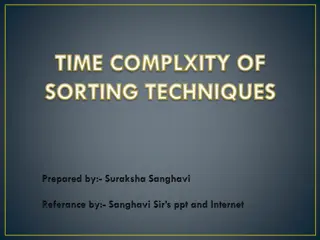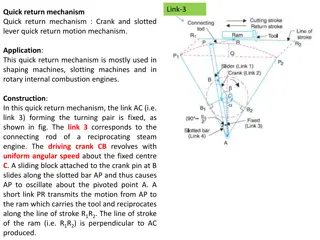Quick Overview on Content Analysis Techniques
Explore the methods and techniques for analyzing content effectively. Learn about text analysis, sentiment analysis, and more in this concise guide.
Download Presentation

Please find below an Image/Link to download the presentation.
The content on the website is provided AS IS for your information and personal use only. It may not be sold, licensed, or shared on other websites without obtaining consent from the author.If you encounter any issues during the download, it is possible that the publisher has removed the file from their server.
You are allowed to download the files provided on this website for personal or commercial use, subject to the condition that they are used lawfully. All files are the property of their respective owners.
The content on the website is provided AS IS for your information and personal use only. It may not be sold, licensed, or shared on other websites without obtaining consent from the author.
E N D
Presentation Transcript
Definition of Complex Complexes or coordination compounds are molecules that posess a metal center that is bound to ligands (atoms, ions, or molecules that donate electrons to the metal). These complexes can be neutral or charged. When the complex is charged, it is stabilized by neighboring counter-ions. Normally there are two spheres, i.e inner outer ones, in the inner coordination sphere, which is also referred to in some texts as the first sphere, ligands are directly bound to the central metal. In the outer coordination sphere, sometimes referred to as the second sphere, other ions are attached to the complex ion. 2
Definition of complex complex" indicate a compound that consists of a metal atom or ion in the center, surrounded by ligands. i.e. a metal center plus ligands is commonly called a complex. 3
Example 4
Example The image above shows a cobalt (III) complex (or coordination entity). The central metal ion has six ammonia molecules attached - these attached molecules are called ligands. The complex forms because the lone pairs of electrons on the ammonia ligands are attracted to the positive charge on the cobalt ion. The bond between a ligand and the central metal is weaker than a typical covalent or ionic bond. Another way of saying this is that a complex forms when a lewis acid (the metal in the center) and lewis base(s) (the ligands) combine to form a coordination compound. The complex has the same charge as the central cobalt, because the ammonia ligands are neutral. The three chloride ions are not ligands, they are normal chloride ions; they form ionic bonds with the cobalt 5
Example 2 Fe(H2O)63+ 6
Properties of Coordination Complexes Some methods of verifying the presence of complex ions include studying its chemical behavior. This can be achieved by observing the compounds' color, solubility, absorption spectrum, magnetic properties, etc. The properties of complex compounds are separate from the properties of the individual atoms. By forming coordination compounds, the properties of both the metal and the ligand are altered. Metal-ligand bonds are typically thought of Lewis acid- base interactions. The metal atom acts as an electron pair acceptor (Lewis acid), while the ligands act as electron pair donors (Lewis base). The nature of the bond between metal and ligand is stronger than intermolecular forces because they form directional bonds between the metal ion and the ligand, but are weaker than covalent bonds and ionic bonds. 7
Examples of complex compounds Complex compds. CN O.S of metal [Fe(CN)6]4- 6 2+ [Co(NH3)4SO4] 5 1+ [Pt(NH3)4]2+ 4 2+ [Ni(NH2CH2CH2NH2)3]2+ 6 2+ 8
Common Ligands Monodentate ligands donate one pair of electrons to the central metal atoms. An example of these ligands are the haldide ions (F-, Cl-, Br-, I-). Polydentate ligands, also called chelates or chelating agents, donate more than one pair of electrons to the metal atom forming a stronger bond and a more stable complex. A common chelating agent is ethylenediamine (en), which, as the name suggests, contains two ammines or :NH2sites which can bind to two sites on the central metal. An example of a tridentate ligand is bis- diethylenetriammine. An example of such a coordination complex is bis-diethylenetriamine cobaltIII. 9
Complexes The nature of ligands Simple ligands include water, ammonia and chloride ions. What all these have got in common is active lone pairs of electrons in the outer energy level. These are used to form co- ordinate bonds with the metal ion. All ligands are lone pair donors. In other words, all ligands function as Lewis bases. 10
Ligands Bidentate ligands Bidentate ligands have two lone pairs, both of which can bond to the central metal ion. The two commonly used examples are 1,2-diaminoethane (old name: ethylenediamine - often given the abbreviation "en"), and the ethanedioate ion (old name: oxalate). In the ethanedioate ion, there are lots more lone pairs than the two shown, but these are the only ones we are interested in. You can think of these bidentate ligands rather as if they were a pair of headphones, carrying lone pairs on each of the "ear pieces". These will then fit snuggly around a metal ion. Ni (NH2CH2CH2NH2)32+ You might find this abbreviated to [Ni(en)3]2+. 11
Structures of complex 6-co-ordinated complex ions These are complex ions in which the central metal ion is forming six bonds. In the simple cases we are talking about, that means that it will be attached to six ligands. These ions have an octahedral shape. Four of the ligands are in one plane, with the fifth one above the plane, and the sixth one below the plane. From the diagram below remember that the ligands attached to a wedge shaped arrow are coming out of the screen or paper towards you. Those attached to a dotted arrow are behind the plane of the screen or paper. The two ligands attached to the ordinary arrows are above and below the plane of the rest 13
Structure of Complex Four examples of octahedral ions. 14
Structure of Complex 4-co-ordinated complex ions These are far less common, and they can take up one of two different shapes. Tetrahedral ions These are the ones you are most likely to need for A' level purposes. There are two very similar ions which crop up commonly at this level: [CuCl4]2-and [CoCl4]2-. The copper(II) and cobalt(II) ions have four chloride ions bonded to them rather than six, because the chloride ions are too big to fit any more around the central metal ion as shown in the diagram below. 15
Tetrahedral 16
Structure of Complex A square planar complex Occasionally a 4-co-ordinated complex turns out to be square planar. There's no easy way of predicting that this is going to happen. The only one you might possibly come across at this level is cisplatin which is used as an anti-cancer drug. Cisplatin is a neutral complex, Pt(NH3)2Cl2. It is neutral because the 2+ charge of the original platinum(II) ion is exactly cancelled by the two negative charges supplied by the chloride ions. 17
Structure of Complex square planar complex The platinum, the two chlorines, and the two nitrogens are all in the same plane. 18
Structure of Complex Stereoisomerism in complex ions Some complex ions can show either optical or geometric isomerism 19
Isomerism Geometric isomerism This occurs in planar complexes like the Pt(NH3)2Cl2we've just looked at. There are two completely different ways in which the ammonias and chloride ions could arrange themselves around the central platinum ion: 20
Isomerism 21
Isomerism The two structures drawn are isomers because there is no way that you can just twist one to turn it into the other. The complexes are both locked into their current forms. The terms cis and trans are used in the same way as they are in organic chemistry. Trans implies "opposite" - notice that the ammonias are arranged opposite each other in that version, and so are the chlorines. Cis implies "on the same side" - in this instance, that just means that the ammonias and the chlorines are next door to each other. 22
Isomerism Optical isomerism You recognise optical isomers because they have no plane of symmetry. In the organic case, it is fairly easy to recognise the possibiliy of this by looking for a carbon atom with four different things attached to it. It isn't qute so easy with the complex ions - either to draw or to visualise! The examples you are most likely to need occur in octahedral complexes which contain bidentate ligands - ions like [Ni(NH2CH2CH2NH2)3]2+or [Cr(C2O4)3]3-. 23
Substitution Reactions: Inert and Labile Compounds Substitution reaction in complexes is same as in any other compound, i.e. replacing one ligand by another Particularly when the starting material is an aqueous solution, where the metal ion is likely to be in the form of [M(H2O)m]n+ Some simpler reactions of this type produce colored products that can be used to identify metal ions. E.g. [Ni (H2O)6]2+ + 6NH3 [Ni (NH3)6]2+ + Green Blue 6H2O 24
Substitution Reactions: Inert and Labile Compounds The above reaction and many of its kind react rapidly. Complexes which react rapidly are called labile. Taube has suggested a reaction half life time of one minute or less as the criterion for lability. Compounds that react slowly are called inert. An inert compound is not inert in the sense that no reaction can take place; it is simply slower to react. E.g. of inert compound is Hexaaminecobalt 3+ [Co(NH3)6]3+ + 6H3O+ [ Co(H2O)6]3+ + 6NH4+ This reaction has high activation enrgey therefore react very slowly Complexes can be described as substitutionally labile or inert 25
Substitution Reactions: Inert and Labile Compounds Although not completely absolute, but general rules can be given for these types of reaction, i.e. inert and labile. Inert octahedral complexes are generally those with high ligand field stabilization energies II. Complexes with d3 and low spin d4 to d6 electronic structures react inert III. Complexes with d8 configurations generally react somewhat faster, but d7, d9 and d10 react even faster IV. High spin d4, d5 and d6 react labile V. Strong-field d8 (square planar) react inert I. 26
Substitution Reactions: Inert and Labile Compounds 27
General Substitution Reactions of Octahedral Complexes: Reaction Mechanisms for Octahedral Substitution i. Aquation replacement of ligand X by H2O, where X is the labile ligand. There are two kinds of substitution reactions that can be studied: ML5X + H2O ML5H2O + X ii. Anation replacement of H2O by ligand X- (anion) ML5H2O + X ML5X + H2O The direct replacement of X by Y cannot be studied: ML5X + Y ML5 Y +X is not known. It always goes via the aquo complex, i.e. in two steps, the replacement of one ligand with water, then water is replaced with another ligand 28
General Substitution Reactions of Octahedral Complexes Ligand substitution reactions are those in which the coordination sphere around the metal changes due to exchange of one ligand with another The most extensively studied reactions of coordination compounds i.e. measuring rates of water exchange in aquo metal ions Generally octahedral substitution can be written as follows: ML6 + Y ML5Y + L 29
General Substitution Reactions of Octahedral Complexes Replacement of coordinated solvent ( eg water). Perhaps the most thoroughly studied replacement reactions of this type is the formation of a complex ion from a hydrated metal ion in solution. 30
General Substitution Reactions of Octahedral Complexes Anation: When the entering group is an ion the reaction is called anation . 31
General Substitution Reactions of Octahedral Complexes Solvolysis. Since the majority of such reactions have been carried out in aqueous solution, hydrolysis is a more appropriate term. Hydrolysis reactions have been done under acidic or basic conditions . 32
Substitution Reactions of Octahedral Complexes: Mechanisms Classification of Substitution Mechanisms Intimate Mechanism Dissociative 5-Coordionate Transition State for Octahedral Reactant Associative 7-Coordinate Transition State for Octahedral Reactant Dissociative activation D Id Ia A Associative activation Alternative Labels SN1 lim (Limiting first- order nucleophilic substitution) SN2 Lim (Limiting second-order nucleophilic substitution) 33
Substitution Reactions of Octahedral Complexes: Mechanisms Kinetics We can therefore say from the above table that:- If we determine the rate law for the reaction if it depends on only [ML5X] then it is dissociative. If it does depend on [ML5X] and [Y] then it is associative. BUT - coordination chemistry kinetics are not quite so simple The actual mechanisms may be more complicated than those differentiated between A and D Experimental conditions may mask the dependence of a rate on the concentration of the incoming ligand 34
Substitution Reactions of Octahedral Complexes: Mechanisms Kinetics For an Associative Mechanism we have seen that: Rate determining step (slow step) is the collision between the original complex ML5X and the incoming ligand Y to produce a 7 coordinate intermediate ML5XY. The second faster step is dissociation of the X ligand to produce the desired product. The associative mechanism predicts that the rate of reaction depends on the concentration of ML5X and Y. Rate = k1[ML5X][Y] 35
Substitution Reactions of Octahedral Complexes: Mechanisms Kinetics But note that the above is not strictly the case when Y is H2O. The concentration of water is so large that it is essentially a constant, we cannot dilute water! Hence Rate = k1[ML5X] Therefore here we can see that the experimental conditions mask the dependence of a rate on the concentration of the incoming ligand. Now we are unable to distinguish between the associative and dissociative mechanism from the reaction kinetics 36
Substitution Reactions of Octahedral Complexes: Mechanisms Kinetics The Interchange Mechanism (I) As Y begins to bond X begins to leave. i.e. the bond making to Y and bond breaking to X occur simultaneously (organic SN2) Although we speak generally about associative and disassociative reaction mechanisms, the terms A and D are reserved for situations where 7 and 5 coordinate intermediates have actually been isolated and positively identified. If no intermediates have been isolated or identified the designations Id and Ia are more appropriate 37
Substitution Reactions of Octahedral Complexes: Mechanisms Kinetics Now consider the possible reaction mechanisms of substitution in octahedral complexes from the point view of ligand field theory (Molecular Orbital Method) using the model proposed by Jorgensen et al with angular parameters First the reaction can be an SN1 or an SN2 mechanisms In SN1 the activated complex has the composition ML5 and the rate determing step is determined by the equation ML6 = ML5 +L After this the new ligand then rapidly adds to the activated complex to form the desired product 38
Substitution Reactions of Octahedral Complexes: Mechanisms Kinetics The kinetics for the above reaction can be written as -Ld Li LnM-Ld ------------- LnM- ------------LnM-Li K1 K2 The rate limiting step is K1 Since k1 is rate limiting, k2 is assumed to be much larger than k1 When we solve for all the intermediate and simplify our equation we will end up with Rate = K1 [LnM-Ld] Unlike the associative rate law, this rate does not depend on the concentration of incoming ligand 39
Experimental Conditions There is masking of concentration dependence in aqueous solution. An dissociative mechanism is first order in the concentration of the complex reactant. An associative mechanism is first order in both complex reactant and in the incoming water ligand. For example ML5 X + H2O ---------ML5H2O The concentration of H2O in aqueous solution is so large it is very nearly constant. So it is combined with k1 and the resulting rate law is pseudo first order. The dependence of the associative mechanism on the concentration of the incoming ligand has been masked. 40
Experimental Conditions For this reaction we cannot determine the Y dependence because H2O exchange is more likely to occur. We cannot do anything about this because we cannot vary the concentration of H2O. H20 replacement of X proceeds more rapidly than replacement of H2O by Y. Water is in great excess over Y Conclusions The rate law for all of these mechanisms is identical: Rate = k1[ML5X] So we cannot use the rate law to decide between the two mechanisms. BUT we now know that dissociative mechanisms are generally preferred! How can we deduce this? 41
Experimental Conditions Additional Evidence for a Dissociative Pathway for Octahedral Substitution Reactions What other data can we use? - 3 types: i. Entering Group ii. Leaving Group Iii. Steric Hindrance i. Entering Group Effect [Ni(H2O)6 ]2+ + L [Ni(H2O)5 L]2++ H2O We can vary L 42
Experimental Conditions If we compare the rate constants for the substitution reactions, look at their values then we can see that the largest difference is for anionic compared to neutral ligands: For example: NH3= 3x103, CH3COO-= 30 x 103 so a factor of 10 difference So the conclusion is that the rate doesn t depend on the incoming ligand significantly which is consistent with the loss of water being rate determining and a dissociative rate determining step which a water molecule breaks away from the Ni(II) and in a succeeding fast step is replaced by L. 43
Experimental Conditions ii. Effects of Leaving Group Table 5.2 shows how the rate of the reaction measured by (k, s-1) now depends on the strength of the metal- ligand bond. The rate constants k refer to the following reactions: 44
Experimental Conditions Dissociation of a ligand from an octahedral complex generates an usaturated ML5 intermediate. When all five of the remaining ligands are L-type, as in Cr(CO)5, the metal has 6 d electrons for a total electron count of 16. The trigonal bipyramidal geometry problems (unpaired electrons) for 6 d electrons. The orbital energy levels come from crystal field theory. Distortion to a square pyramid or a distorted TBP geometry removes the electronic issue, and so five-coordinate d6 complexes typically have square pyramidal or distorted TBP geometries. This is just thegeometry prediction process in action, associative substitution, fluxionality in the five- coordinate intermediate stereochemistry of the reaction. presents electronic can complicate the 45
Experimental Conditions There are features that stabilize the unsaturated intermediate. Electronically, the intermediate loves it when its d electron count is nicely matched to its crystal field orbitals. This follows that there are certain natural d electron counts for particular geometries that fit well with the metal-centered orbitals predicted by crystal field theory. Octahedral geometry is great for six d electrons, for example, and square planar geometry loves eight d electrons. Complexes with natural d electron counts but bearing one extra ligand are ripe for dissociative substitution. The classic examples are d8 TBP complexes, which become d8 square planar complexes (think Pt(II) and Pd(II)) upon dissociation. Similar factors actually stabilize starting 18- electron complexes, making them less reactive in dissociative substitution reactions. d6 octahedral complexes are particularly happy, and react most slowly in dissociative substitutions. The three most common types of 18-electron complexes, from fastest to slowest at dissociative substitution, are: d8 TBP > d10 tetrahedral > d6 octahedral 46
Experimental Conditions Steric Hindrance Consider the following two reactions: [CoCl2(en)2]+ + H2O [CoCl(H2O)(en)2]+ + Cl- [CoCl2(Me4en)2]++ H2O [CoCl(H2O)(Me4en)2]++ Cl- For this dissasociative reaction steric crowding is reduced by the loss of Cl if it was associative we would go via a 7-coordinate intermediate so we would expect the reaction to be considerably slowed by steric strain. It is not! As steric bulk on the ligand increases, dissociation becomes more favorable. 47
Experimental Conditions Factors Affecting the Rate of Octahedral Substitution. 1. Size and Charge of Metal the strongest bonds occur for the smallest size and higher charge on the metal. 2 Change in CFSE complexes with d3 low spin d6 configurations and d 2 8 . Change in CFSE complexes with d3, low spin d6 configurations and d8 exchange ligands slowly. This is because you loose a lot of crystal field stabilization energy when going to 5 co-ordinate. (any geometry is less than octahedral in terms of CFSE). If we compare Al3+and Cr3+Both metals have the same size Cr3+ has 3 d electrons and Al3+ has none Cr 3+ exhibits slow exchange whereas exchange is rapid for Al3+ 48
Outer- Sphere and Inner - sphere reactions Let us start with oxidation -reduction reactions of transitional metal complexes This involved the transfer of an electron from one specie to another like in any REDOX reaction That means transfer from one complex to another, which may be connected by a common ligand through which the electron is transferred The above then is a bridging or inner sphere reaction The exchange of the electron may occur between two separate coordination spheres in a nonbridging or outer- sphere reaction 49
Outer- Sphere and Inner = sphere reactions The rate of electron transfer reaction depends on many factors such as :- (i)Rate of substitution in the coordination sphere of the reactants (ii) The match of the energy levels of the reactants (iii) Solvation of the reactants (iv)Nature of the ligands 50























